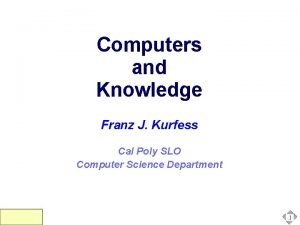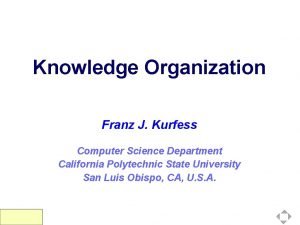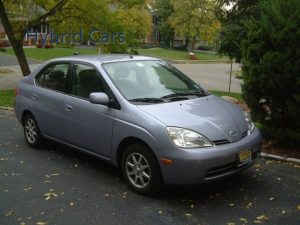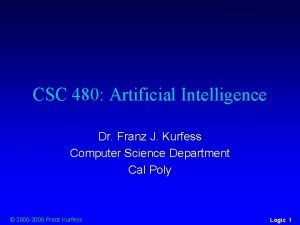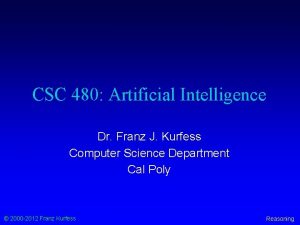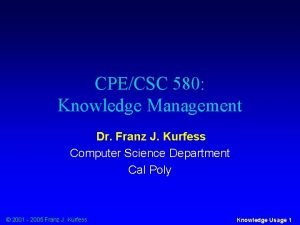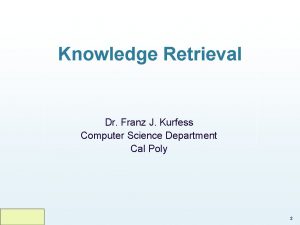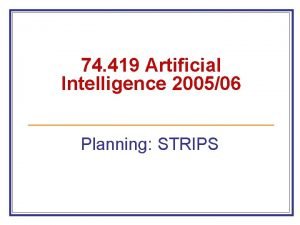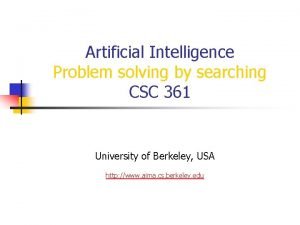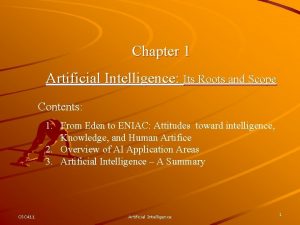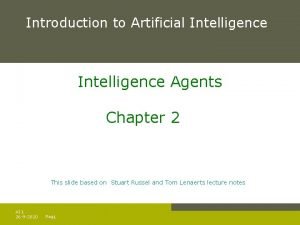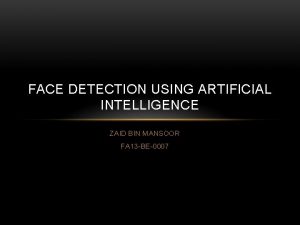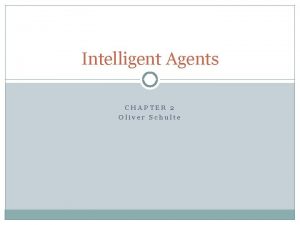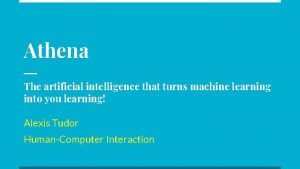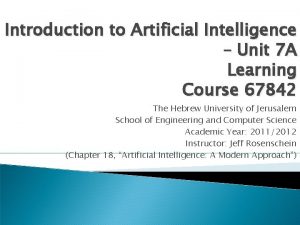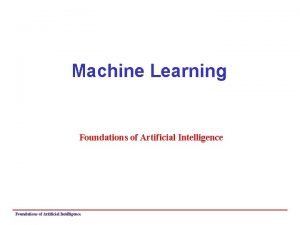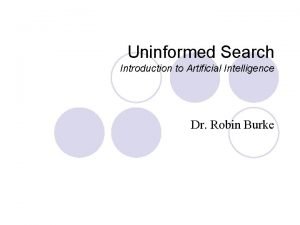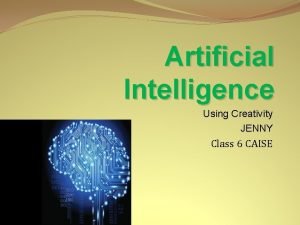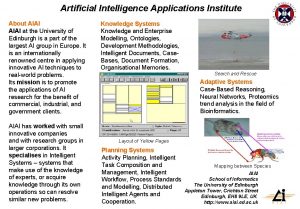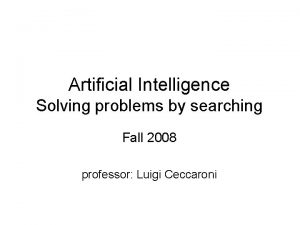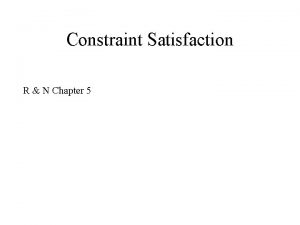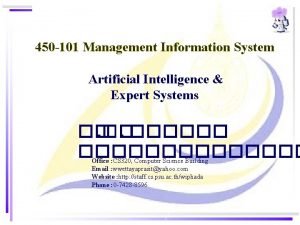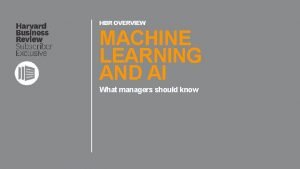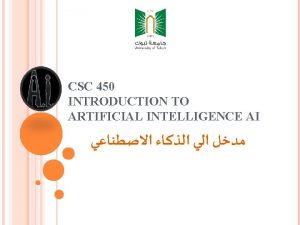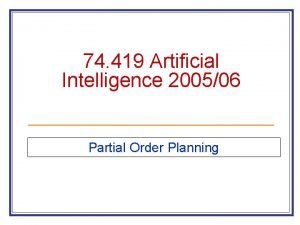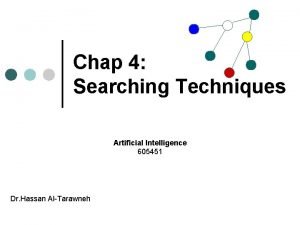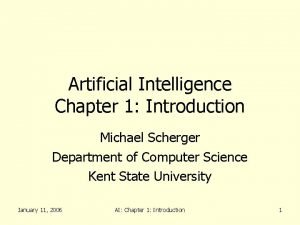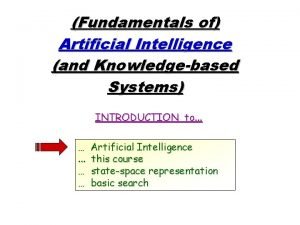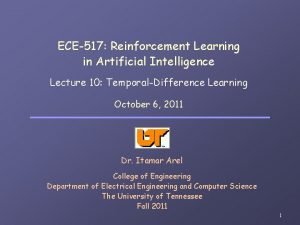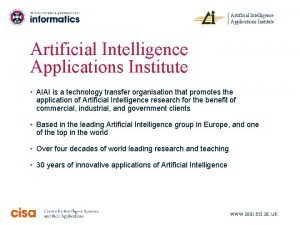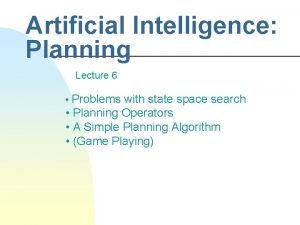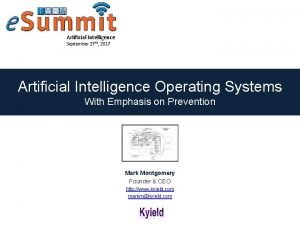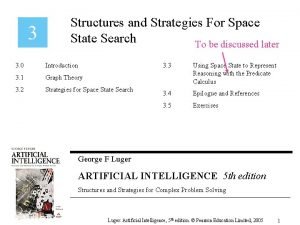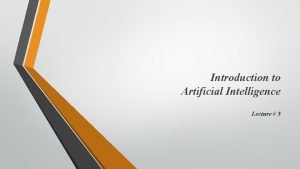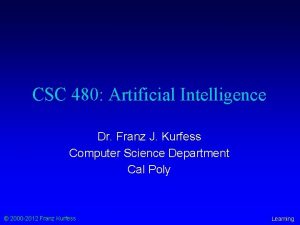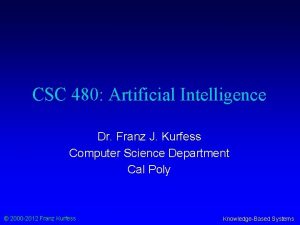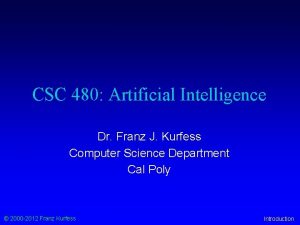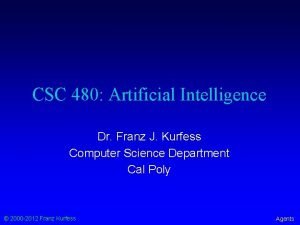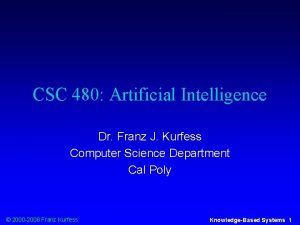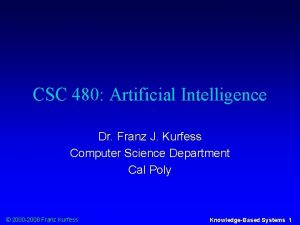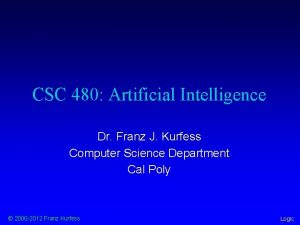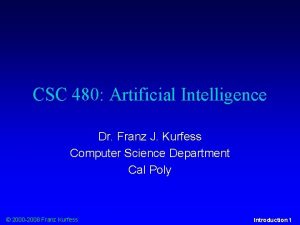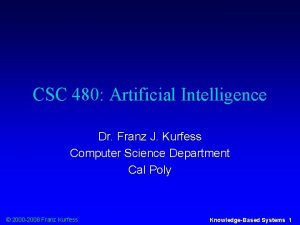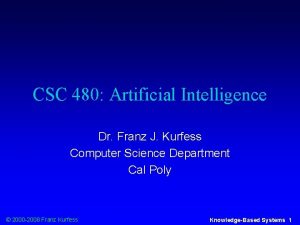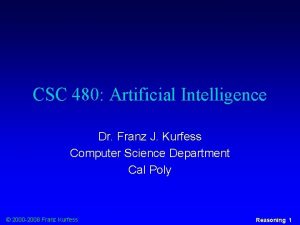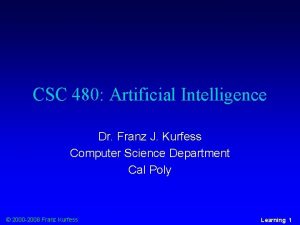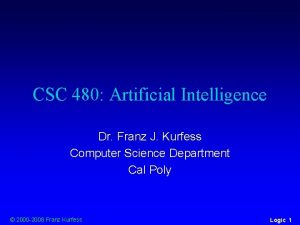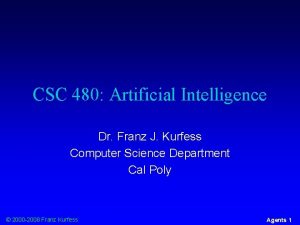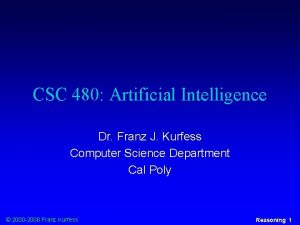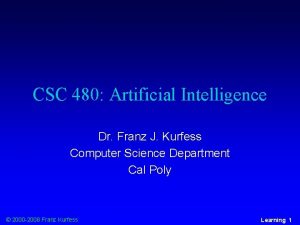CSC 480 Artificial Intelligence Dr Franz J Kurfess















































- Slides: 47

CSC 480: Artificial Intelligence Dr. Franz J. Kurfess Computer Science Department Cal Poly © 2000 -2008 Franz Kurfess Agents 1

Course Overview u Introduction u Intelligent Agents u Search u u problem solving through search informed search u Games u games as search problems u Knowledge u u and Reasoning reasoning agents propositional logic predicate logic knowledge-based systems u Learning u u learning from observation neural networks u Conclusions © 2000 -2008 Franz Kurfess Agents 2

Chapter Overview Intelligent Agents u Motivation u Agent u Objectives u u Introduction u u Agents and Environments u Rationality u Agent Structure u u u Types Simple reflex agent Model-based reflex agent Goal-based agent Utility-based agent Learning agent u Important Concepts and Terms u Chapter Summary © 2000 -2008 Franz Kurfess Agents 3

Logistics u Handouts u Web page u Blackboard System u Term Project u Lab and Homework Assignments u Exams © 2000 -2008 Franz Kurfess Agents 4

Motivation u agents are used to provide a consistent viewpoint on various topics in the field AI u agents require essential skills to perform tasks that require intelligence u intelligent agents use methods and techniques from the field of AI © 2000 -2008 Franz Kurfess Agents 7

Objectives u introduce the essential concepts of intelligent agents u define some basic requirements for the behavior and structure of agents u establish mechanisms for agents to interact with their environment © 2000 -2008 Franz Kurfess Agents 8

What is an Agent? u in general, an entity that interacts with its environment u perception through sensors u actions through effectors or actuators © 2000 -2008 Franz Kurfess Agents 10

Examples of Agents u human agent v v eyes, ears, skin, taste buds, etc. for sensors hands, fingers, legs, mouth, etc. for actuators v u robot v v camera, infrared, bumper, etc. for sensors grippers, wheels, lights, speakers, etc. for actuators v u powered by muscles often powered by motors software agent v functions as sensors v v information provided as input to functions in the form of encoded bit strings or symbols functions as actuators v results deliver the output © 2000 -2008 Franz Kurfess Agents 11

Agents and Environments u an agent perceives its environment through sensors u the complete set of inputs at a given time is called a percept u the current percept, or a sequence of percepts may influence the actions of an agent u it can change the environment through actuators u an operation involving an actuator is called an action u actions can be grouped into action sequences © 2000 -2008 Franz Kurfess Agents 12

Agents and Their Actions ua rational agent does “the right thing” u the action that leads to the best outcome under the given circumstances u an agent function maps percept sequences to actions u abstract mathematical description u an agent program is a concrete implementation of the respective function u it runs on a specific agent architecture (“platform”) u problems: u what is “ the right thing” u how do you measure the “best outcome” © 2000 -2008 Franz Kurfess Agents 13

Performance of Agents u criteria for measuring the outcome and the expenses of the agent u often subjective, but should be objective u task dependent u time may be important © 2000 -2008 Franz Kurfess Agents 14

Performance Evaluation Examples u vacuum agent u number of tiles cleaned during a certain period based on the agent’s report, or validated by an objective authority v doesn’t consider expenses of the agent, side effects v v v energy, noise, loss of useful objects, damaged furniture, scratched floor might lead to unwanted activities v agent re-cleans clean tiles, covers only part of the room, drops dirt on tiles to have more tiles to clean, etc. © 2000 -2008 Franz Kurfess Agents 15

Rational Agent u selects the action that is expected to maximize its performance u based on a performance measure u depends on the percept sequence, background knowledge, and feasible actions © 2000 -2008 Franz Kurfess Agents 16

Rational Agent Considerations u performance measure for the successful completion of a task u complete perceptual history (percept sequence) u background knowledge u especially v about the environment dimensions, structure, basic “laws” u task, user, other agents u feasible actions u capabilities © 2000 -2008 Franz Kurfess of the agent Agents 17

Omniscience ua rational agent is not omniscient u it doesn’t know the actual outcome of its actions u it may not know certain aspects of its environment u rationality takes into account the limitations of the agent u percept sequence, background knowledge, feasible actions u it deals with the expected outcome of actions © 2000 -2008 Franz Kurfess Agents 18

Environments u determine to a large degree the interaction between the “outside world” and the agent u the “outside world” is not necessarily the “real world” as we perceive it u in many cases, environments are implemented within computers u they may or may not have a close correspondence to the “real world” © 2000 -2008 Franz Kurfess Agents 19

Environment Properties u fully u observable vs. partially observable sensors capture all relevant information from the environment u deterministic u changes in the environment are predictable u episodic u vs. dynamic no changes while the agent is “thinking” u discrete u u vs. continuous limited number of distinct percepts/actions u single u vs. sequential (non-episodic) independent perceiving-acting episodes u static u vs. stochastic (non-deterministic) vs. multiple agents interaction and collaboration among agents competitive, cooperative © 2000 -2008 Franz Kurfess Agents 20

Environment Programs u environment simulators for experiments with agents u gives a percept to an agent u receives an action u updates the environment u often divided into environment classes for related tasks or types of agents u frequently provides mechanisms for measuring the performance of agents © 2000 -2008 Franz Kurfess Agents 21

From Percepts to Actions u if an agent only reacts to its percepts, a table can describe the mapping from percept sequences to actions u instead of a table, a simple function may also be used u can be conveniently used to describe simple agents that solve well-defined problems in a well-defined environment v e. g. calculation of mathematical functions © 2000 -2008 Franz Kurfess Agents 22

Agent or Program u our criteria so far seem to apply equally well to software agents and to regular programs u autonomy u agents solve tasks largely independently u programs depend on users or other programs for “guidance” u autonomous systems base their actions on their own experience and knowledge u requires initial knowledge together with the ability to learn u provides flexibility for more complex tasks © 2000 -2008 Franz Kurfess Agents 23

Structure of Intelligent Agents u Agent = Architecture + Program u architecture u operating v platform of the agent computer system, specific hardware, possibly OS functions u program u function actions that implements the mapping from percepts to emphasis in this course is on the program aspect, not on the architecture © 2000 -2008 Franz Kurfess Agents 24

Software Agents u also referred to as “softbots” u live in artificial environments where computers and networks provide the infrastructure u may be very complex with strong requirements on the agent u World u natural Wide Web, real-time constraints, and artificial environments may be merged u user interaction u sensors and actuators in the real world v camera, temperature, arms, wheels, etc. © 2000 -2008 Franz Kurfess Agents 25

PEAS Description of Task Environments used for high-level characterization of agents Performance Measures used to evaluate how well an agent solves the task at hand Environment surroundings beyond the control of the agent Actuators determine the actions the agent can perform Sensors provide information about the current state of the environment © 2000 -2008 Franz Kurfess Agents 26

Exercise: Vac. Bot Peas Description u use the PEAS template to determine important aspects for a Vac. Bot agent © 2000 -2008 Franz Kurfess Agents 27

PEAS Description Template used for high-level characterization of agents Performance Measures How well does the agent solve the task at hand? How is this measured? Environment Important aspects of theurroundings beyond the control of the agent: Actuators Determine the actions the agent can perform. Sensors © 2000 -2008 Franz Kurfess Provide information about the current state of the environment. Agents 28

Agent Programs u the emphasis in this course is on programs that specify the agent’s behavior through mappings from percepts to actions u less on environment and goals u agents u they receive one percept at a time may or may not keep track of the percept sequence u performance evaluation is often done by an outside authority, not the agent u more objective, less complicated u can be integrated with the environment program © 2000 -2008 Franz Kurfess Agents 36

Skeleton Agent Program u basic framework for an agent program function SKELETON-AGENT(percept) returns action static: memory action memory : = UPDATE-MEMORY(memory, percept) : = CHOOSE-BEST-ACTION(memory) : = UPDATE-MEMORY(memory, action) return action © 2000 -2008 Franz Kurfess Agents 37

Look it up! u simple way to specify a mapping from percepts to actions u tables may become very large u all work done by the designer u no autonomy, all actions are predetermined u learning might take a very long time © 2000 -2008 Franz Kurfess Agents 38

Table Agent Program u agent program based on table lookup function TABLE-DRIVEN-AGENT(percept) returns action static: percepts // initially empty sequence* table // indexed by percept sequences // initially fully specified append percept to the end of percepts action : = LOOKUP(percepts, table) return action * Note: the storage of percepts requires writeable memory © 2000 -2008 Franz Kurfess Agents 39

Agent Program Types u different ways of achieving the mapping from percepts to actions u different levels of complexity u simple reflex agents u agents that keep track of the world u goal-based agents u utility-based agents u learning agents © 2000 -2008 Franz Kurfess Agents 40

Simple Reflex Agent u instead of specifying individual mappings in an explicit table, common input-output associations are recorded u requires processing of percepts to achieve some abstraction u frequent method of specification is through condition-action rules v if percept then action u similar to innate reflexes or learned responses in humans u efficient implementation, but limited power environment must be fully observable v easily runs into infinite loops v © 2000 -2008 Franz Kurfess Agents 41

Reflex Agent Diagram What the world is like now Condition-action rules Agent © 2000 -2008 Franz Kurfess What should I do now Actuators Environment Sensors Agents 42

Reflex Agent Diagram 2 Sensors What the world is like now Condition-action rules What should I do now Agent Actuators Environment © 2000 -2008 Franz Kurfess Agents 43

Reflex Agent Program u application of simple rules to situations function SIMPLE-REFLEX-AGENT(percept) returns action static: rules //set of condition-action rules condition : = INTERPRET-INPUT(percept) rule : = RULE-MATCH(condition, rules) action : = RULE-ACTION(rule) return action © 2000 -2008 Franz Kurfess Agents 44

Exercise: Vac. Bot Reflex Agent u specify a core set of condition-action rules for a Vac. Bot agent © 2000 -2008 Franz Kurfess Agents 45

Model-Based Reflex Agent u an internal state maintains important information from previous percepts u sensors only provide a partial picture of the environment u helps with some partially observable environments u the internal states reflects the agent’s knowledge about the world u this knowledge is called a model u may contain information about changes in the world caused by actions of the action v independent of the agent’s behavior v © 2000 -2008 Franz Kurfess Agents 46

Model-Based Reflex Agent Diagram Sensors State What the world is like now How the world evolves What my actions do Condition-action rules What should I do now Agent Actuators Environment © 2000 -2008 Franz Kurfess Agents 47

Model-Based Reflex Agent Program u application of simple rules to situations function REFLEX-AGENT-WITH-STATE(percept) returns action static: rules //set of condition-action rules state //description of the current world state action //most recent action, initially none state : = UPDATE-STATE(state, action, percept) rule : = RULE-MATCH(state, rules) action : = RULE-ACTION[rule] return action © 2000 -2008 Franz Kurfess Agents 48

Goal-Based Agent u the u agent tries to reach a desirable state, the goal may be provided from the outside (user, designer, environment), or inherent to the agent itself u results of possible actions are considered with respect to the goal u u u easy when the results can be related to the goal after each action in general, it can be difficult to attribute goal satisfaction results to individual actions may require consideration of the future v v u very what-if scenarios search, reasoning or planning flexible, but not very efficient © 2000 -2008 Franz Kurfess Agents 49

Goal-Based Agent Diagram Sensors State How the world evolves What the world is like now What happens if I do an action What my actions do Goals What should I do now Agent Actuators Environment © 2000 -2008 Franz Kurfess Agents 50

Utility-Based Agent u more sophisticated distinction between different world states ua utility function maps states onto a real number v may be interpreted as “degree of happiness” u permits rational actions for more complex tasks resolution of conflicts between goals (tradeoff) v multiple goals (likelihood of success, importance) v a utility function is necessary for rational behavior, but sometimes it is not made explicit v © 2000 -2008 Franz Kurfess Agents 51

Utility-Based Agent Diagram Sensors State How the world evolves What my actions do What the world is like now What happens if I do an action How happy will I be then Utility What should I do now Agent Actuators Environment © 2000 -2008 Franz Kurfess Agents 52

Learning Agent u performance element u selects actions based on percepts, internal state, background knowledge u can be one of the previously described agents u learning element u identifies improvements u critic u provides feedback about the performance of the agent u can be external; sometimes part of the environment u problem generator u suggests actions u required for novel solutions (creativity © 2000 -2008 Franz Kurfess Agents 53

Learning Agent Diagram Performance Standard Critic Sensors State Learning Element How the world evolves What my actions do What the world is like now What happens if I do an action How happy will I be then Utility Problem Generator What should I do now Actuators Environment © 2000 -2008 Franz Kurfess Agents 54

Important Concepts and Terms u u u u action actuator agent program architecture autonomous agent continuous environment deterministic environment discrete environment episodic environment goal intelligent agent knowledge representation mapping multi-agent environment © 2000 -2008 Franz Kurfess u u u u observable environment omniscient agent PEAS description percept sequence performance measure rational agent reflex agent robot sensor sequential environment software agent state static environment sticastuc environment utility Agents 57

Chapter Summary u agents perceive and act in an environment u ideal agents maximize their performance measure u autonomous u basic agents act independently agent types u simple reflex u reflex with state u goal-based u utility-based u learning u some environments may make life harder for agents u inaccessible, continuous © 2000 -2008 Franz Kurfess non-deterministic, non-episodic, dynamic, Agents 58

© 2000 -2008 Franz Kurfess Agents 59
 Franz kurfess
Franz kurfess Franz kurfess
Franz kurfess 480+480
480+480 Csc 480 degrees
Csc 480 degrees Csc 480
Csc 480 Stephen kurfess
Stephen kurfess Ned kurfess
Ned kurfess Differentiate between a* and ao* algorithm
Differentiate between a* and ao* algorithm Differentiate between strips and adl
Differentiate between strips and adl Int 404
Int 404 State space search ai
State space search ai Problem solving by searching in artificial intelligence
Problem solving by searching in artificial intelligence A fuzzy proposition
A fuzzy proposition Artificial intelligence chapter 1
Artificial intelligence chapter 1 Types of agents in artificial intelligence
Types of agents in artificial intelligence Bin zaid face
Bin zaid face Agent in artificial intelligence
Agent in artificial intelligence Kinship domain in artificial intelligence
Kinship domain in artificial intelligence Athena machine learning
Athena machine learning Unit 7 artificial intelligence
Unit 7 artificial intelligence What is meta knowledge in artificial intelligence
What is meta knowledge in artificial intelligence Learning in ai
Learning in ai Uninformed search in artificial intelligence
Uninformed search in artificial intelligence What is artificial intelligence class 6
What is artificial intelligence class 6 Artificial intelligence applications institute
Artificial intelligence applications institute Solving problems by searching artificial intelligence
Solving problems by searching artificial intelligence P e a s
P e a s Waltz algorithm in artificial intelligence
Waltz algorithm in artificial intelligence Difference between informed and uninformed search
Difference between informed and uninformed search Artificial intelligence devices
Artificial intelligence devices Andrew ng hbr
Andrew ng hbr Artificial intelligence
Artificial intelligence Searching for solutions in artificial intelligence
Searching for solutions in artificial intelligence Artificial intelligence thesis proposals
Artificial intelligence thesis proposals Partial order planning in artificial intelligence
Partial order planning in artificial intelligence Artificial intelligence class 8 chapter 3 solutions
Artificial intelligence class 8 chapter 3 solutions Searching techniques in artificial intelligence
Searching techniques in artificial intelligence Artificial intelligence chapter 1
Artificial intelligence chapter 1 Cse 471 asu
Cse 471 asu Fundamentals of artificial intelligence
Fundamentals of artificial intelligence Passive reinforcement learning in artificial intelligence
Passive reinforcement learning in artificial intelligence Artificial intelligence applications institute
Artificial intelligence applications institute Planning in artificial intelligence
Planning in artificial intelligence Artificial intelligence operating system
Artificial intelligence operating system Artificial intelligence graph
Artificial intelligence graph Cpsc 322 ubc
Cpsc 322 ubc Colbert, stephen. home page. 1 nov. 2006.
Colbert, stephen. home page. 1 nov. 2006. Production rule for water jug problem
Production rule for water jug problem
